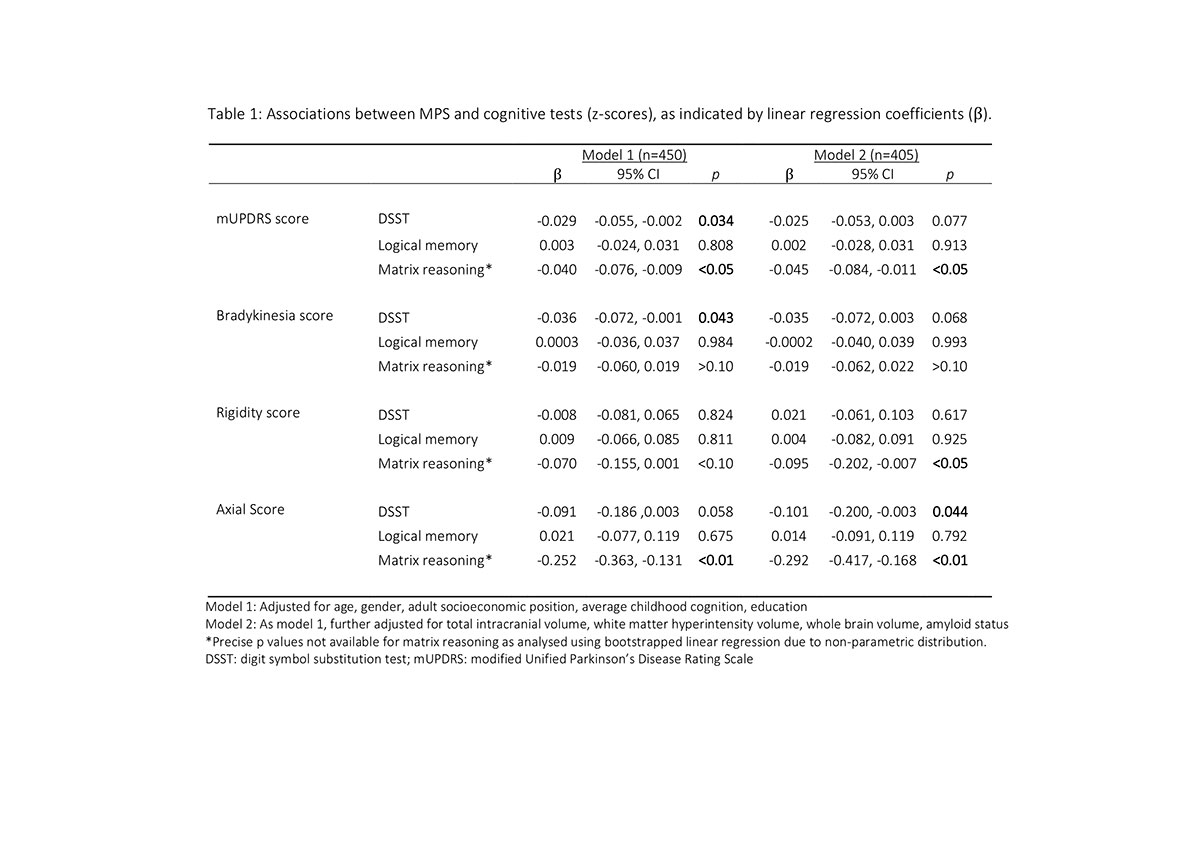Session Information
Date: Wednesday, September 25, 2019
Session Title: Cognition and Cognitive Disorders
Session Time: 1:15pm-2:45pm
Location: Agora 3 East, Level 3
Objective: To test associations between mild parkinsonian signs (MPS), cognitive function and brain pathologies in Insight 46, a subsample of the MRC National Survey of Health and Development (NSHD), the British 1946 birth cohort.
Background: MPS increase in frequency with age and have been associated with increased risks of mild cognitive impairment, Alzheimer’s disease (AD) and mortality. However, relationships between MPS, cognition and neuropathology remain unclear.
Method: 502 individuals were recruited to Insight 46. Participants had a clinical assessment including parkinsonian signs using the Movement Disorder Society Unified Parkinson’s disease Rating Scale (MDS-UPDRS); a cognitive battery including tests of psychomotor speed (Digit-Symbol Substitution Test, DSST), non-verbal reasoning (Matrix Reasoning), and memory (Logical Memory story recall); and imaging using volumetric T1 and FLAIR MRI, and Florbetapir amyloid-PET. A modified MDS-UPDRS (mUPDRS) (excluding action and kinetic tremor) was used to determine bradykinesia, rigidity, rest tremor and axial sub-scores. After excluding individuals with major clinical or radiological brain disease, data were analysed to assess associations between motor scores and cognitive performance using multivariable linear regression adjusting for demographics and childhood cognition (n=450, model 1), and imaging metrics (n=405, model 2).
Results: Mean age was 70.7 years (SD 0.7); 49.6% were female. Median mUPDRS score was 2 (range 0–21). Only two participants had rest tremor so this was not analysed. No motor score was associated with logical memory. Higher total mUPDRS score was associated with lower DSST (p<0.05) and matrix reasoning (p<0.05) scores. Higher axial scores were associated with decreased matrix reasoning (p<0.01) and a trend towards lower DSST (p<0.06); higher bradykinesia associated with lower DSST (p<0.05). Adjusting for amyloid status, whole brain, and white matter hyperintensity volumes (model 2) the associations between mUPDRS, bradykinesia, and axial scores with matrix reasoning remained statistically significant. [table 1]
Conclusion: MPS, particularly in an axial distribution, were associated with poorer performance on tasks of non-verbal reasoning and psychomotor speed. The lack of association with the imaging pathologies investigated suggests that these relationships are not underpinned by preclinical AD or typical cerebral small vessel disease.
To cite this abstract in AMA style:
S. Buchanan, C. Lane, K. Lu, T. Parker, S. James, A. Keshavan, S. Keuss, H. Murray-Smith, A. Wong, D. Cash, W. Coath, S. Crutch, N. Fox, M. Richards, A. Schrag, J. Schott. The cognitive profile associated with mild parkinsonian signs in a British Birth Cohort at age 69-71 [abstract]. Mov Disord. 2019; 34 (suppl 2). https://www.mdsabstracts.org/abstract/the-cognitive-profile-associated-with-mild-parkinsonian-signs-in-a-british-birth-cohort-at-age-69-71/. Accessed April 3, 2025.« Back to 2019 International Congress
MDS Abstracts - https://www.mdsabstracts.org/abstract/the-cognitive-profile-associated-with-mild-parkinsonian-signs-in-a-british-birth-cohort-at-age-69-71/

